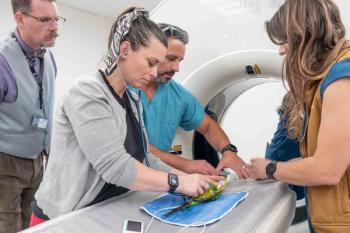
Ultrasonography of lymph nodes, vessels, and abdominal effusions: what can I see? (Proceedings)
Clipping the hair and applying alcohol and ultrasound gel is important for maximizing image quality. Ultrasound of the entire abdomen is recommended to evaluate for lymphadenopathy, effusions and vascular abnormalities.
General considerations
Clipping the hair and applying alcohol and ultrasound gel is important for maximizing image quality. Ultrasound of the entire abdomen is recommended to evaluate for lymphadenopathy, effusions and vascular abnormalities. Changing transducers throughout the exam may be necessary dependent on the size and conformation of the animal. A transducer with a small footprint may be necessary for intercostal or intrapelvic imaging, while a linear or curvilinear can be used often in the mid-abdomen. Generally a 5-15 MHz transducer is adequate for most dogs and cats.
Ultrasound of the normal lymph nodes
Multiple lymph nodes are present in the abdomen. These include hepatic, splenic, gastric, pancreaticoduodenal, jejunal, colic, lumbar aortic, medial iliac, hypogastric, and sacral. These lymph nodes may be difficult to see in cats and dogs if normal. Normal lymph nodes will be oval to fusiform in shape, with smooth margins, and isoechoic relative to surrounding fat. A thin hyperechoic capsule with a small hyperechoic central area, at the hilus, can sometimes be seen. In dogs lymph nodes may be up to 5 mm in diameter (7-8 mm may be normal in larger dogs). Another measurement that can be used is the diameter to length ratio, which should be less than 0.5. In dogs the most commonly identified normal lymph nodes are the jejunal and medial iliac. In cats the most commonly seen normal nodes are the colic.
Ultrasound of abnormal lymph nodes
Enlarged lymph nodes, lymphadenopathy, may be secondary to reactive or neoplastic changes. There is overlap in the ultrasound appearance of the lymph nodes with these diseases. Lymph nodes should be evaluated for change in shape, size, contour, echogenicity, echotexture, and blood flow if color Doppler is available. Lymph nodes with a ratio (diameter to length) greater than 0.5 are most commonly neoplastic. These lymph nodes have become much rounder in shape, which also means there overall size is increased. Abnormal lymph nodes are generally easier to find because they become hypoechoic relative to the surrounding fat. Heterogenous lymph nodes are less common. Generally the hyperechoic hilus will remain visible with reactive nodes, while it will disappear or become distorted with neoplastic infiltrates. If lymph nodes become very enlarged central areas of necrosis (fluid) may be seen. Cysts may be seen with either benign or malignant disease.
Normal or benign lymphadenopathy will generally have a hilar flow pattern with Color Doppler evaluation. Malignant lymphadenopathy will have more of a peripheral or mixed flow pattern.
Ultrasound of peritoneal effusion and other peritoneal abnormalities
The location of peritoneal effusion will often change position with gravity. When the animal is in dorsal recumbency a small volume of effusion is often seen along the left lateral abdomen near the spleen or cranial to the apex of the bladder. Larger volumes of effusion can be seen throughout the abdomen. Fluid around the gall bladder often appears as pseudo thickening of the gall bladder wall. With chronic exudates the fluid may become trapped and not be gravity dependent.
Echogenicity of the fluid will be dependent on the cellular content and other debris. Transudates and modified transudates will be anechoic, while exudates and hemorrhage are generally moderately echogenic. The fluid can sometimes be so echogenic that it is confused with abdominal organs. Distinguishing echogenic fluid from a solid organ can be done by looking for visible motion within the fluid or lack of blood flow. With exudates it is not uncommon to see linear hyperechoic bands due to fibrin strands. Ultimately the exact type of fluid cannot be determined by ultrasound appearance alone and cytology should be performed for a definitive diagnosis.
With peritonitis in addition to finding peritoneal effusion the mesentery, peritoneum, and omentum are often thickened, hyperechoic, and hyperattenuating. This can be a focal or diffuse finding. For example with pancreatitis this may be localized to the cranial abdomen. Gastrointestinal rupture is another common cause of either focal or diffuse peritonitis. If gastrointestinal rupture is suspected evaluating for free gas is important. Free gas will be seen in the non-gravity dependent portion of the abdomen and will be a hyperechoic area not associated with the gastrointestinal tract that has a reverberation artifact (abdominal radiographs are useful for detecting free gas). Often concurrent ileus of the gastrointestinal tract is seen with peritonitis.
If large volumes of free gas are present in the peritoneal space performing an ultrasound exam will be very difficult. Also remember it will be very difficult to perform an ultrasound exam in an animal that has had recent surgery (as free gas and small amounts of fluid are generally present post-operatively).
Peritoneal abscesses, granulomas, neoplasia, or fat necrosis may be seen. Abscesses will have thick, irregular walls with variably echogenic fluid material centrally. Internal gas and septa can be present as well. Granulomas due to fungal disease or pyogranulomas often secondary to foreign material can have a highly variable appearance, but generally will be a hypo to hyperechoic region with surrounding fluid or hyperattenuating fat. Neoplasia can be solitary such as a lipoma or lymphoma of the mesentery. Lipomas will be hyperechoic and hyperattenuationg. Soft tissue sarcomas, particularly of the retroperitoneal space, are also seen. Neoplasia can also be diffuse and is commonly referred to as carcinomatosis. Carcinomatosis is diagnosed if multiple nodules are seen spread throughout the peritoneal cavity. These are more easily seen if concurrent effusion is present, which is often the case. The nodules can be variable in echogenicity. Nodular fat necrosis (seen as mineralized areas on radiographs) is a benign change that is seen as hyperechoic and hyperattenuating nodules or masses in the abdominal fat.
Ultrasound of the normal vasculature
Understanding the vascular anatomy is one of the most important parts of ultrasound evaluation of the abdominal vessels. A right dorsal intercostal approach is good for evaluation of the triad of vessels seen at the hepatic hilus (aorto, portal vein, and caudal vena cava). The splenic vein can often be traced to or towards the portal vein. The renal veins and arteries are fairly easy to trace from the hilus of the kidney to the caudal vena cava and aorta respectively. The trifurcation of the distal aorta and caudal vena cava and the associated external iliac vessels are visible in the caudal abdomen.
Ultrasound of vascular abnormalities
Thrombi or emboli can be identified within the vessels in various locations. The most common areas would be the portal vein, splenic veins, caudal vena cava, and aorta (and associated iliac vessels). Initially the thrombi are poorly echogenic and can be hard to identify. In these cases color Doppler evaluation can be very helpful. If a venous thrombus is suspected you can also evaluate for lack of compressibility (as the veins normally can be compressed with pressure). Over time the thrombus tends to be more easily seen as a hyperechoic, round to ovoid structure within the lumen of the vessels.
Caudal vena cava thrombosis can be seen with neoplasia (liver and adrenal) or hypercoagulable diseases. If the cava is occluded significantly, concurrent peritoneal effusion may be present. In cats cardiomyopathies are a common cause of aortic and iliac thromboembolism.
Mineralization of the vascular walls is sometimes seen, but is considered an incidental finding.
Interventional techniques
Ultrasound guided abdominocentesis is very common and easy to perform. For abdominocentesis a 22-gauge, 1 to 1 ½ inch needle is used.
Ultrasound guided aspirates and biopsy of lymph nodes and peritoneal masses are also routinely performed. For aspirates a 22-gauge, 1 to 1 ½ inch needle is used. Depending on the location of the lymph nodes they may be aspirated once they are greater than 7 mm in diameter. In cases of lymphoma the aspirates are generally very rewarding. For biopsy the lymph nodes or masses generally are greater than 2 cm in thickness. An 18 to 14-gauge needle may be used. Coagulation profiles are generally performed prior to biopsy.
Newsletter
From exam room tips to practice management insights, get trusted veterinary news delivered straight to your inbox—subscribe to dvm360.






